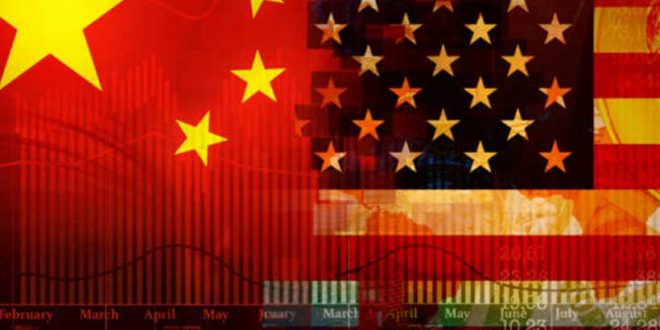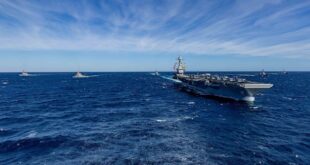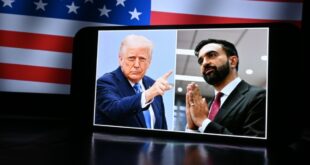Giancarlo Elia Valori
The primary policy line of the People’s Republic of China, above all at sea level, is to defend its strategic and military interests, but anyway without undermining the trade routes and economic relations between China and its neighbouring countries.
Just think about the Spratly issue, but also about the Chinese position on the ownership and nationality of the Senkaku Islands, as well as about the pressure made on China by India in 2017 to block the road that China had planned and designed on the border with Bhutan.
From this viewpoint, China’s tensions in its neighbouring countries have immediately affected Japan, the Philippines, Malaysia and Vietnam.
We should also recall, however, the naval confrontation with the United States in May 2009, especially with the USNS Impeccable and Victorious, for the right to operate in the 200 nautical miles off the Chinese Special Economic Zones.
The United States does not like at all China’s protection of its regional seas, but it will be hard to change China’s mechanism of full protection of its coasts, which partly inhibits the use of old and traditional checkpoints, from Malacca to the Paracel and Ryuku Islands – all areas in which the United States could impose a blockade on the trade and military flows of China’s vessels.
This is still the first goal of China’s regional naval security.
This is one of the primary strategic features of the Belt and Road Initiative, i.e. to get out of the Eastern maritime region and, hence, credibly offset the inevitable imbalance of the Chinese strategic formula on its regional seas with a significant geo-economic presence on Central Asia’s Heartland.
As well as to provide China with a possibility of military (but also geo-economic) countermove capable of blocking the opponent on the sea or, alone, on its land borders.
Therefore the aim pursued by China is its full security and absolute freedom of manoeuvre, within the “first circle” of peripheral islands, but with the possibility of projecting a significant interdiction power beyond this limit.
One of the essential strategic meanings of President Xi Jinping’s Belt and Road Initiative is that, at geo-financial and economic levels, the Chinese leaders are well aware that the global financial crises – the past ones, but also those looming large – make the Chinese economy too vulnerable to global flows.
This is even more severe if you have planned a neo-mercantilist and export-oriented economic development, as the Chinese leaders have done since Deng Xiaoping’s Four Modernizations.
At that time there was no other alternative option.
We also need to consider the tensions in Tibet and Xinjiang, which have also a geo-economic significance.
It should be recalled that in 2000 the Chinese government launched a “Great Development Program for Western Regions” to finally establish a close connection between the land areas of Xinjiang and the Tibet region – which is essential for China’s nuclear defence and intelligence – and the coastal areas’ economic development.
This is also a very useful logical pathway to understand the Belt and Road Initiative well.
Also at military level, which – in the Chinese logic – is closely linked to political decision-making, so far all the 2008 and 2009 “White Papers” of the Chinese Armed Forces have always emphasized the rule of the “three functions and a role”.
It is a rational and operational criterion, which envisages that the Armed Forces should: a) provide the strength to enhance the Party’s leading role, which has always been the first aim of the People’s Liberation Army (PLA); b) provide support to take advantage of this period of great strategic opportunities for China; c) also provide support for the defence of China’s national interests; and, finally, d) play an important role in maintaining world peace and promoting global economic development.
These are not empty words. These are programs.
Reading between the lines, it is said that – beyond the regional seas and networks outside its borders – China will operate in such a way as not to create definitive tensions with its competitors or allies.
Therefore what we need to know is that currently the CPC has the urgent need to define a stable economic development for China.
Thirty years ago the CPC leaders argued – and history has proved them right – that the war between the superpowers would never occur, in line with Mao Zedong’s thinking, whereby imperialism “was a paper tiger”.
A regional, Soviet, Euro-American and partly Middle East paper tiger, in which no one had any interest in firing the first shot.
At the time, however, China was already thinking about Asia, Africa, the “Third World” devoid of “capitalists” or Soviet “revisionists”, left as breeding ground for a new growing great power, which had not been ruined by the crazy Cold War, namely China.
Now – and this is also implicit in the Belt and Road Initiative – the current Chinese leaders obviously think that additional 30 or 40 years of peace and development are needed to enable China to really become a stable and great power.
Hence in terms of current strategic doctrine, so far China has adapted to fight what the Chinese strategists call “a war and a half”. This means that it can and must successfully wage a major war on its own borders, in addition to effectively resisting attacks carried out around other Chinese borders.
We also need to consider the stable Indian garrison of 60,000 soldiers in Southern Tibet, in addition to the very recent Quad 2.0 alliance between the United States, India, Japan and Australia, established precisely to counter the Belt and Road Initiative.
In this case, we have the whole range of potentialities and contrasts facing the Belt and Road Initiative.
Obviously it should also be recalled that at least 22% of Japan’s and Australia’s foreign trade currently depends on China. Hence it is very unlikely that regional and military tension will turn into a real clash.
In its future strategic planning, however, China is preparing to resist an Indian land invasion from the South-East and to simultaneously lead a victorious regional naval confrontation, especially in Taiwan’s peripheral area or in the South China Sea.
Certainly present-day China is simultaneously carrying out the Belt and Road Initiative (BRI) and the Regional Comprehensive Economic Partnership (RCEP), with the ten ASEAN countries and the six ones with which ASEAN has further free trade treaties, as well as with the China-ASEAN Free Trade Area. The United States, however, has already created its anti-BRI commercial and economic network with the US-Mexico-Canada Trade Agreement (USMCA), and then with the probable reformulation of a proposal from the old Trans-Pacific Partnership (TTP) or with the new Comprehensive and Progressive Agreement for Trans-Pacific Partnership.
Hence, while the United States is rebuilding its geo-economic centre of gravity in Asia – that it considers to be of primary military and commercial interest – obviously China has turned to Africa, where currently the United States is not particularly engaged.
A Zen game of void and full, where everyone represents both characteristics.
At political and technological levels, the United States is causing severe trouble to China, particularly with the recent creation of a special agency called Review of Controls for Certain Emergent Technologies, an office for “dual use” control regarding biotechnologies, Artificial Intelligence, advanced navigation and positioning systems, data analysis and above all big data, robotics and biotechnology.
This is, in fact, the broader scene of the clash on Huawei and 5G which, as we can imagine, is much more important than the simple organization of an evolved Internet network.
For example, in the 2018 US Cyber Strategy it is argued that the USA must “win two cyber wars simultaneously”, which are clearly wars against the Russian Federation and, above all, against China.
Hence, should the United States led by President Trump fail to fully win their current trade war with China, it could use the cyber leverage to redress the global balance of power, with a clear support action taken by the other NATO countries – an action which is necessary from the political and military viewpoints.
One will be used in the absence of the other – the greater the Chinese commercial presence in the leading sectors, the greater the tendency and likelihood of a cyber war against China.
And the other way round.
There is more, however, in relation to the clash between the United States and China and, hence, in relation to the necessary and logical shift of China to a closer bond with the EU, its individual Member States and the rest of the world.
For example, The National Defense Authorization Act of 2019, published on August 13, 2018, focuses on the operations of the Chinese ZTE corporation, while the US government is prohibited from purchasing all Huawei’s materials – as is now well-known – but also the products of Dahua, which deals with video surveillance, as well as the products of Hytera, which manufactures advanced radio systems and, finally, of Hikvision, the current largest producer of video surveillance systems in the world.
As has long been happening, in all the US government official documents China is also seen as a dangerous competitor of almost equal rank and power.
Is it a realistic project? The answer is both yes and no. At technological level, probably in the future. At financial and commercial levels, not yet.
Nevertheless the matter here is tuer dans l’oeuf, namely to nip in the bud.
It should also be recalled that, again in August 2018, US President Trump announced 25% additional tariffs and duties on 50 billion US imports/year from China and later 10% additional tariffs and duties on other 200 billion Chinese goods exported to the United States. Last September further duties on Chinese exports to the USA were announced to the tune of additional 267 billion dollars.
Last autumn, at the UN General Assembly, the United States made public the “alleged” China’s influence operations against the Republican Party (only?) in the midterm elections while, at the same time, Terry Branstad – the US ambassador to China since 2017, a “friend of President Xi” and former Governor of Iowa twice – published an article condemning China’s “influence operations” in Iowa.
The United States has also put great pressure on El Salvador to avoid it breaking with Taiwan. Later, however, the United States exerted further very strong pressures on the IMF, with a view to stopping funds for Pakistan that would partly be used to repay old Chinese loans to the country.
Also President Trump’s move to withdraw from the INF Treaty – which apparently concerns, above all, the Russian Federation – anyway puts also China under military pressure.
Nevertheless, there is the stick and also the carrot for the future US friends in Asia: last August, in fact, US Secretary of State Mike Pompeo proposed a package of financial aid for Asia to the tune of 300 million dollars, to which other 133 million dollars would be added, albeit only for specific support to private companies operating in the region.
The BUILD Act has created a new US government agency, namely the U.S. International Development Finance Corporation, with as many as 60 billion dollars of US funds already available abroad, above all to Asia – a very evident response to the Belt and Road Initiative.
Hence what will the United States do in the future, considering that the bilateral clash with China is now seen as structural?
Surely, the battle over duties will continue and it is now possible that, in only two other moves, all Chinese imports to the USA will be heavily and selectively taxed.
In any case, the United States will try to hit the companies that are most active in the Chinese project known as Made in China 2025.
The current Chinese leaders’ project is modelled on the German one, known as Industry 4.0, and is already focused on the general technological upgrade of Chinese public and private companies, with the predetermined increase of components and spare parts manufactured nationally from 40% in 2020 to 70% in 2025.
There is also the construction of centres for productive innovation – that is already at an advanced stage – which will be 15 in 2020 and 40 in 2025. There will also be a change and a significant strengthening of internal intellectual property rights.
Innovation will be mainly focused on: 1) a new information technology; 2) robotics and the automated production of consumer goods and capital equipment; 3) aerospace and aeronautics; 4) hi-tech shipping; 5) railways; 6) vehicles with new energy and motion systems; 7) energy; 8) agricultural technologies; 9) new materials; 10) biopharma and advanced biomedical technologies.
In the official Chinese documents, there is no mention of “autonomous innovation” in all these sectors – as was the case in previous projects as from 2006 – and it is not here just a matter of innovation, but of entire production processes.
Autonomous innovation is internal activity and here the Chinese government makes us understand that there is a global research and experimentation activity open to collaborations with the EU, Japan and Korea.
Hence, where possible, the United States will hit exactly in these sectors, by avoiding – to any possible extent – any kind of technology transfer or, in any case, any transfer of ad hoc scientific information.
Furthermore, in the future, the United States will have the opportunity of convincing both Japan and the EU to implement practices against China featuring sanctions and open trade restriction, not only at technological level. Certainly Italy will harshly experience this kind of operations, whether they are known or not to our intelligence Services.
How will China respond to these practices? Probably with a hard and close dialogue, although with some significant concessions to the United States.
Furthermore, in the framework of China’s technological upgrade program, its leaders will have the chance to increase the non-State sphere in China’s production system. Finally China will look for new foreign markets. This is the first CPC’s response.
Most likely, the Chinese leaders will also avoid the additional burden of public debt on companies and, above all, they will largely limit the growth of real estate speculation.
In all likelihood, China will spend a lot of money on productive investment – as already envisaged in its 2025 Plan – and will look for new external markets, above all (but not only) with the Belt and Road Initiative.
It should be recalled that currently the BRI countries account for 27.3% of the total Chinese foreign trade with the United States alone.
Moreover, China will soon develop excellent regional free trade agreements, such as with the Regional Comprehensive Economic Partnership and the enlarged ASEAN.
Furthermore, nothing forbids to reach a great agreement with India.
In the future, however, China’s trade interest will be, above all, in Japan and South Korea.
Meanwhile, the United States can carefully assess the military and commercial cost of an all-out economic war against China, which will certainly not be irrelevant.
This is context in which we can see the weak and tired interests of the European Union, which does not know its destiny and hence will not have one. The same applies to Italy which could use the potential of the Road and Belt Initiative, but will not be in a position to do so and, above all, will have no way out of the US strategic, military and financial pressure.
Honorable de l’Académie des Sciences de l’Institut de France
President of International World Group
 Geostrategic Media Political Commentary, Analysis, Security, Defense
Geostrategic Media Political Commentary, Analysis, Security, Defense





